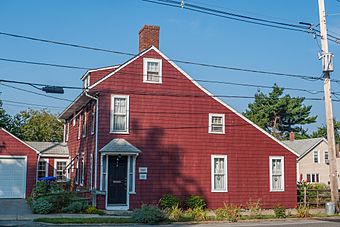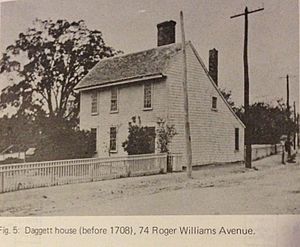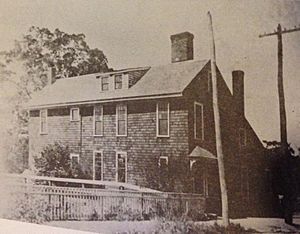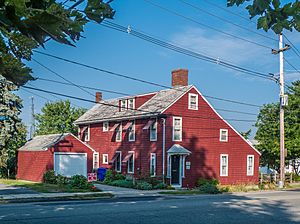Nathaniel Daggett House facts for kids
See also Daggett House, Slater Park, Pawtucket RI, built about the same time, by Nathaniel's father John.
Quick facts for kids |
|
|
Nathaniel Daggett House
|
|
 |
|
| Location | East Providence, Rhode Island |
|---|---|
| Built | 1700 |
| MPS | East Providence MRA |
| NRHP reference No. | 80000092 |
| Added to NRHP | November 28, 1980 |
The Nathaniel Daggett House is a very old building in East Providence, Rhode Island. It's also known as "The House that Never Moved".
The oldest part of this house was likely built before the year 1700. This makes it one of the oldest buildings in East Providence. Even though the house has always stayed in the same spot, it has been part of different towns, states, and colonies over time!
What the House Looks Like
The Nathaniel Daggett House sits close to the street. It is in a neighborhood that was first settled a long time ago. Most of the other houses there were built much later.
The house first had two stories and a simple roof. It was made of wood and had a chimney at one end. There was probably only one room on each floor. A small entrance and stairs were in front of the chimney. Later, a single-story addition was built at the back. This made the roof look like a "saltbox" shape, which means it slopes down very far in the back.
Around 1900, a company called American Electrical Works bought the house. They fixed it up to house their workers. They added two more sections to the front of the house. The stairs were rebuilt, and the front door was moved. Older windows were replaced, and new windows were added in the attic. This allowed people to live in the attic space. More recently, a garage was added to the side of the house.
Even with all these changes, the house still has many original parts. You can still see how the house was first laid out. Some old wooden posts and two-panel doors are still there. The original large fireplace also remains, though a smaller, newer fireplace is now inside it. The older parts of the house still feel very old. With more work, its ancient history could be even clearer.
Why This House is Important
The Nathaniel Daggett House is one of the oldest homes still standing in East Providence. It is a rare example of how houses were built in early colonial times. It's special because of how it was made bigger. Instead of adding to the side of the chimney, they added a lean-to at the back. This was more common in northern Rhode Island than in Massachusetts. This shows how closely connected Providence and western Rehoboth were, even though they were in different colonies.
The Daggett House has been known as a historical site for a long time. People call it "the house that never moved." This name refers to the fact that the house has stayed in its original spot. Yet, the land around it changed from being part of three towns and two states. It's a cool story that shows how people view local history.
People cared a lot about saving this house because of its connection to early history. It was especially linked to the settlement started by Roger Williams nearby. In the 1890s, the house was almost torn down. This was to make way for a new road and a streetcar line. But people were very upset about this. The Rhode Island Historical Society formed a group to save the house. The house was saved, but it was changed a lot to become housing for workers. Today, the Daggett House is an important historical building for East Providence.
The house was officially added to the National Register of Historic Places on November 28, 1980. This means it is recognized as a special historical place.
Who Owned the House
In 1632, Roger Williams wrote about how the King's land grants were unfair. He believed land should be bought from Native Americans. In 1635, he was sent away from the Massachusetts Bay Colony for his ideas. In the spring of 1636, Roger Williams bought land from the Wampanoag leader, Massasoit. This land was on the northeast shore of Seekonk Cove. His family and followers joined him there. Old stories say that holes in the ground on the Daggett Farm were once the cellars of Williams's settlement.
However, officials from Plymouth said Williams was on their land. They warned they might arrest him. So, Williams decided to move across the Seekonk River to what is now Providence. That area was outside of any existing land grants.
In 1687, Nathaniel Daggett, who was 26, married Rebecca Miller. He bought a large piece of land near the Seekonk and Ten Mile Rivers. He built the two-room house for his wife and their five children. The house stayed in the Daggett family for about 200 years.
By the late 1800s, the area around the house had become a big industrial zone. There were many factories and homes for workers. The Ten Mile River was dammed to create Omega Pond for factory use. For a few years, the pond and river were popular for fun activities. In the late 1890s, there were plans to straighten Roger Williams Avenue. This would have meant tearing down the Nathaniel Daggett house. But people protested, and the historic house was saved.
American Electrical Works, a big local company, bought the Daggett house. They also bought much of the nearby land for worker housing. They updated and expanded the house in 1900. In 1927, the company sold off its worker housing.
For almost 90 years, the Nathaniel Daggett House has had three owners. They have all taken good care of the house. The only major change has been adding a garage and a small connecting walkway.






